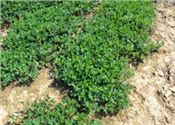Peanut Yield, Prices Look Strong For 2021

Peanuts in Claiborne County, Mississippi, are in good condition on Aug. 16, 2021. Mississippi growers planted about 17,300 acers this year.
Photo by Mississippi State University Extension Service/Susan Collins- Smith
MISSISSIPPI STATE, MISS.
Mississippi’s peanut crop is well on its way to a strong finish for 2021. “The crop is in good condition,” said Brendan Zurweller, peanut specialist with the Mississippi State University Extension Service. “Although our acreage is down from last year, we should have close to the same average yield as last year.”
Zurweller said he expects the state will average between 4,000 and 4,200 pounds per acre this year. That is down slightly from the 2020 average of 4,400 pounds per acre, which was the best average yield on record for Mississippi peanut growers.
Mississippi growers planted 17,340 acres of peanuts, which is about 20 percent less than the acreage in 2020. Improved markets for other commodities and a late planting window contributed to the decrease in acreage.
According to the U.S. Department of Agriculture National Agricultural Statistics Service, 82 percent of peanuts are pegging – or beginning to produce fruit – and 5 percent have been dug as of Aug. 15. The report shows 62 percent of the crop is in good condition, 24 percent is in fair condition, and 8 percent is in poor condition. The remaining 6 percent is in excellent condition.
“In addition to later plantings and cool temperatures this year, wet weather throughout the early and middle part of the growing season slowed crop development in many areas of the state,” Zurweller said.
In other areas of the state, fields could use a little rain, said Malcolm Broome, Mississippi Peanut Growers Association executive director. Peanut plants should completely cover the rows and row middles. Some fields have not reached this stage yet.
“Believe it or not, we have a spot or two in the state that is now dry,” he said. “A half-inch to an inch of rain could make a lot of difference. We don’t want it too wet. We don’t need the rain to set in and stay, but a few showers would help.”
As harvest gets closer, growers need warm weather to keep maturity on track.
“One of the main management issues from here on out is to keep disease pressure low,” Zurweller said. “Also, cool weather in September could delay harvest maturity, and we’re already running a little late. Maintaining late-season canopy health by reducing foliar disease will help prevent peanuts from having to be dug too early.”
A strong yield is necessary to keep prices at their current projections, said Will Maples, Extension agricultural economist.
“Peanuts are currently facing strong, healthy demand, and we need a good-yielding crop to maintain pace,” Maples said. “In the peanut market, the carryforward from year to year, or how many peanuts we have in storage, is an important economic indicator. Current carryforward projections for the 2021–2022 marketing year from the USDA are 1.13 million tons, which is up slightly from 1.08 million tons last year.”
The projected national average farm price for peanuts is $415 per ton, according to the USDA. ∆